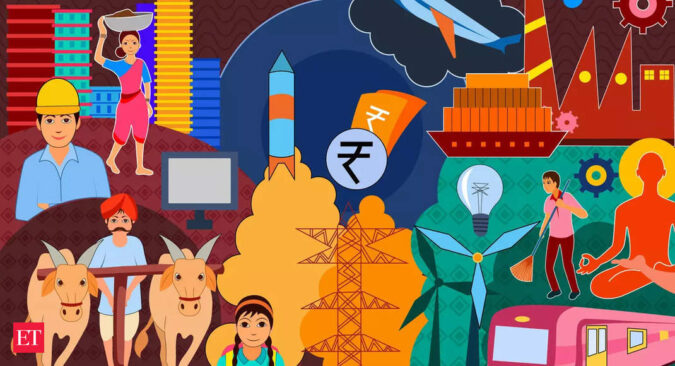The downside risks to the official forecast of 6.5% for real GDP growth in FY24 dominate upside risks, the finance ministry wrote in its monthly economic review.
“OPEC’s surprise production cut has seen oil prices rise in April, off their lows of low-Seventies per barrel in March. Further troubles in the financial sector in advanced nations can increase risk aversion in financial markets and impede capital flows. Forecasts of El Nino, at the margin, have elevated the risks to Indian monsoon rains,” the ministry said.
Meanwhile, global economic prospects also remain uncertain. Elevated inflation and financial tightening, which have weakened the growth process, are thus expected to weigh on economic activity for at least three years since the armed conflict broke out between Russia and Ukraine in February 2022, the ministry noted.
However, the country is still projected to be the world’s fastest growing economy in the financial year 2024 underpinned by robust macroeconomic conditions. Growing macroeconomic stability as seen in the improved current account deficit, easing inflation pressure, and a banking system strong enough to survive the increase in policy rates, has made the growth rate further sustainable.
Little Boy – El Nino
El Nino (little boy in Spanish) conditions may lead to drought conditions, lower agricultural output and elevate prices, the ministry said.The high probability of an El Nino effect this year has raised dark clouds over the monsoon season. The government weather office, India Meteorological Department, had forecast a normal rainy season, but private weather service Skymet has predicted below normal monsoon in the June-September season.
Adequate and timely monsoon showers are vital for India’s agriculture sector, the main source of livelihood for some 60% of its population and which accounts for about 18% of the economy. Nearly half of India’s farmland, which has no irrigation cover, depends on annual June-September rains to grow crops such as rice, corn, cane, cotton and soybeans.
In fact, the El Nino weather phenomenon along with the prevalent scorching heat in many parts of India are a double whammy.
Oil Cartel’s Muscle Strength
“The volatility in crude oil markets continues, with OPEC+ countries deciding to cut crude oil production from May 2023. This has already led to a spike in crude oil prices in April 2023,” the finance ministry said.
However, the upside risk to prices appears to be short-term, as oil demand is expected to remain weak amid the global slowdown. Further, a built-up in inventories and a possible increase in US oil output will continue to put downward pressure on prices, the ministry added.
Earlier this month, a surprise output cut decision by the oil cartel fuelled fears of further inflationary pressures at a time of lingering recession worries and threats to the banking sector.
This is increasingly worrying for India, because it buys around 85% of its crude oil needs from overseas markets which stretches its trade deficit. It also causes fluctuations in global assets, including pushing US treasury yields higher, impacting investors in the Asian nation.
Banking Crisis in Advanced Nations
India is well protected against financial instability and there are less chances of an SVB-like event here backed by the multifaceted nature of RBI’s regulatory actions, the improved bank balance sheets and the attunement of the country’s banking system to frequent interest rate cycles, the ministry said.
These factors will also help support the medium-term growth trajectory to remain on course.
“However, rising uncertainty leaves no space for complacency and dynamic risk identification and management will be critical, especially in the current credit upcycle,” it added.
The recent collapses of a few banks in the US and Europe on the back of this tightening cycle have posed pertinent questions to policy makers on the vulnerability of their financial systems, particularly in emerging market economies, the report said.
In March, the US saw its second and third largest banking failures (Silicon Valley Bank and First Republic Bank), and days after Swiss banking giant Credit Suisse got into an excruciating financial crisis, which was then rescued by UBS via a buyout.
The Positives
“Internal macroeconomic stability has further strengthened with easing inflationary pressures in March 2023, driven by the softening of food and core inflation, which fell to a 16 month low,” the finance ministry said.
It noted that the sequential growth of CPI-core in March 2023 is the weakest since June 2022 and can be attributed to the beginning of the pass-through of declining WPI inflation in consumer goods prices.
“The easing of international commodity prices, the promptness of measures taken by the government, and monetary tightening by the RBI have helped to rein in domestic inflation. Inflationary expectations also appear to be anchoring, as witnessed in various surveys for households and businesses. “
However, core inflation continues to be sticky in many major economies, prompting faster-than-expected policy rate hikes by central banks.
Fiscal parameters for the central and state governments in the last financial year were robust, as seen in solid revenue generation and improvement in the quality of expenditure.
The finance ministry is also hopeful that further rise in forex reserves by the end of FY23 may help the current account deficit to narrow more in Q4.
